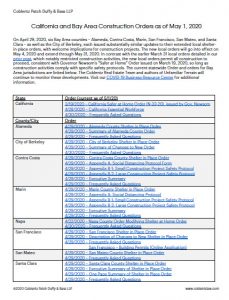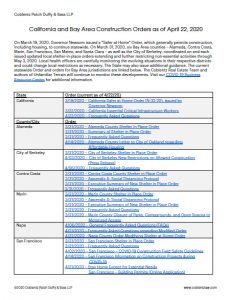By Miles Imwalle, KT Van Dusen, and Charmaine Yu. Originally published in Law360, July 24, 2020.
Click here to download a PDF of this article.
When the California Legislature enacted S.B. 35 in 2017, the goal of the law was clear: to increase the state’s housing production by requiring swift approval of housing in communities often opposed to new development.
The law was designed to bypass community opposition from vocal neighbors or anti-development groups, as well as from local elected officials, who often feel beholden to the interests of local neighbors rather than the needs of the greater regional community.
Recent research highlights the problem with the existing entitlement process for housing. In a series of papers[1] coming out of the University of California, Berkeley, and Columbia University, researchers studied the entitlement process and timelines for housing in several Bay Area and Southern California cities.
For those in the industry, the results were not surprising: Housing entitlements are generally discretionary, and the type of approval, the timing, the number of hearings, the approval body and compliance with California Environmental Quality Act all vary considerably between jurisdictions.
In some jurisdictions, getting through the process is relatively straightforward. In others, it is a slog. The number of units approved also varies significantly, but jurisdictions with efficient, shorter timeframes produce more units.
S.B. 35 only applies to communities that have failed to meet their regional housing needs; as a practical matter, almost all communities in California are subject to S.B. 35. It offers a creative cure for the traditional, lengthy and discretionary approval process that delays, or blocks, so many housing and mixed use developments. It allows for streamlined approval of projects that meet specific objective standards — a mix of statewide and local laws.
Projects are eligible if they dedicate at least two-thirds of their space to residences or residential uses, if they include an appropriate mix of affordable and market rate units, and if they are built in urban areas, among other objective standards.
A city has either 90 or 180 days (depending on project size) to complete its determination whether the proposed S.B. 35 project complies with these objective standards. In order to reject an S.B. 35 application, the city must timely issue a written determination identifying the objective standard(s) with which the project conflicts.
If the city does not issue this written determination, then the project is deemed to satisfy S.B. 35’s standards. Neither elected officials nor project opponents can otherwise “inhibit, chill, or preclude” a project application. A city cannot withhold approval of a project that complies with the objective standards.
But, in California, approval of a project is often just the beginning of protracted litigation with project opponents. And local governments may not always apply S.B. 35 as strictly as they should. Because S.B. 35 had not been tested in court until recently, lingering questions remained. Could local opposition groups use S.B. 35 to seek judicial review of a city’s approval of an S.B. 35 project? Could a local government deny S.B. 35 approval even if it could not identify an objective standard with which the project application conflicted?
Two recent cases from the Superior Court of California, County of Santa Clara, have confirmed S.B. 35 as the powerful a tool that many housing advocates and developers had hoped it would be: Local opposition groups cannot use S.B. 35 to require a city to withdraw an approval, and a local government is deemed to have approved a project if it fails to follow S.B. 35’s strict structure and timelines.
In Friends of Better Cupertino v. City of Cupertino, a case involving redevelopment of the Vallco Fashion Mall in Cupertino, a proposed S.B. 35 mixed-use project would add 2,402 units of housing to Cupertino, including 1,201 affordable units. Cupertino city staff reviewed the project application and determined that it met S.B. 35’s objective standards. But a local opposition group, which had opposed redevelopment at the Vallco mall for years, filed a writ petition, arguing that the city should not have approved it.
On May 6, the superior court rejected each of petitioner’s arguments in a detailed, carefully reasoned decision. As a factual matter, the court determined that the Vallco project actually complied with S.B. 35’s objective standards. But the court’s most significant holding involved the question whether a city could ever be required to reverse an approval. The court determined that a city is never required to reject an S.B. 35 project.
Indeed, by deeming a project compliant with S.B. 35’s standards in the event a city fails to process an application, S.B. 35 specifically contemplates that some projects will receive S.B. 35 streamlined approval even if they do not meet the objective standards as a matter of fact. For that same reason, a court cannot issue an order compelling a city to reverse its decision to approve an S.B. 35 project. The law never requires an application to be rejected, and the court cannot compel what the law does not require.
The Vallco decision will substantially restrict, if not eliminate, challenges to S.B. 35 projects by project opponents. The holding means that project opponents have no right to ask a court to reconsider whether a project actually meets S.B. 35’s objective standards. If a project is approved under S.B. 35, a developer can be reasonably certain the approval will withstand legal challenges.
The other recent S.B. 35 case involved a 15-unit development in Los Altos. The city of Los Altos attempted to deny a 15-unit project submitted under S.B. 35. But the city’s denial letter did not follow S.B. 35’s strict requirement to identify specific objective standards with which the project conflicted.
Instead, the denial letter referenced vague, unmeasurable standards like whether parking access was adequate. In the decision, issued on April 27, the same court ruled that Los Altos’ denial letter was inconsistent with S.B. 35 and therefore ineffective. Because the city failed to issue a valid inconsistency determination within the statutory deadline, the project was deemed to comply with objective standards as a matter of law. The court directed the city to approve the project.
The Los Altos decision, if upheld on appeal, will ensure that cities cannot shirk their responsibilities under S.B. 35. Only if a project conflicts with objective standards can it be denied. And if a city fails to timely and properly determine whether the project is consistent with objective standards, then the project will be permitted to proceed.
In tandem, these two decisions illustrate that S.B. 35 is a powerful tool — not just to obtain swift approval of a development, but also to avoid lengthy litigation challenges. Cities have limited authority to deny project applications, and local opposition groups cannot ask courts to second-guess whether a project should have received approval under S.B. 35.
The law is beginning to work as intended — the path is now clear to develop much-needed housing in two South Bay communities. Moreover, the decisions should help shape S.B. 35 as a force to ensure needed housing development both in the Bay Area and throughout California.
Miles Imwalle, KT Van Dusen and Charmaine Yu are partners at Coblentz Patch Duffy & Bass LLP.
Disclosure: Coblentz Patch Duffy & Bass LLP attorneys assisted Vallco Property Owner LLC and its affiliate, Sand Hill Property Company, during all stages of entitlements and in the litigation relating to the Vallco project, Friends of Better Cupertino, et al. vs. City of Cupertino, et al.
The opinions expressed are those of the author(s) and do not necessarily reflect the views of the firm, its clients, or Portfolio Media Inc., or any of its or their respective affiliates. This article is for general information purposes and is not intended to be and should not be taken as legal advice.
[1] https://www.law.berkeley.edu/research/clee/research/land-use/getting-it-right

